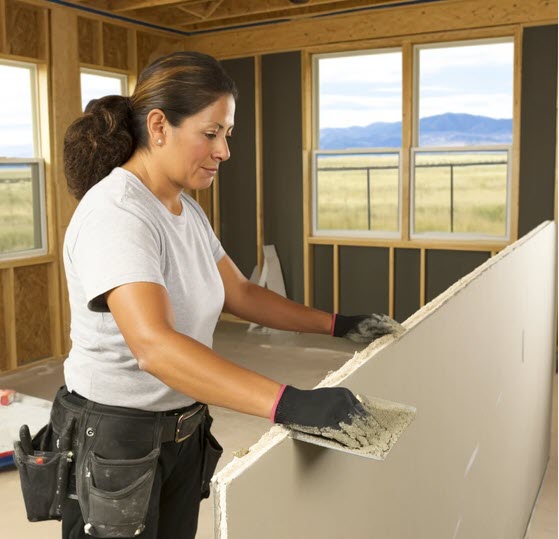Comprehensive Drywall Contractor Assistance for New Builds
Comprehensive Drywall Contractor Assistance for New Builds
Blog Article
Drywall Setup Made Easy: Tips for Perfect Results
Drywall installation is usually viewed as a complicated task, yet with the ideal approach and expertise, it can become a workable endeavor. Understanding strategies for cutting, hanging, and ending up drywall can considerably influence the outcome.
Selecting the Right Products
Selecting the appropriate materials for drywall setup is vital to attaining a long lasting and visually pleasing finish. sheetrock repair fort worth. The primary element, drywall sheets, typically come in numerous densities, with 1/2-inch sheets being basic for indoor wall surfaces. For locations requiring additional wetness resistance, such as kitchen areas or shower rooms, take into consideration using green board or cement board, which are particularly made to withstand humidity

Additionally, picking the best fasteners-- either screws or nails-- is important for securing the drywall to the framing. Drywall screws are generally preferred for their holding power and lowered threat of standing out. Take into consideration the finishing touches such as primer and paint, which not only boost the look yet likewise protect the drywall from dampness and wear.
Preparing the Installment Area
Prior to starting the drywall setup procedure, it is necessary to prepare the installation location extensively. A clean work space reduces the threat of damage to existing products and permits for effective activity during setup.
Following, inspect the wall surfaces and ceiling for any kind of flaws, such as splits, openings, or mold. Address these problems ahead of time; patch any type of problems and allow enough time for repairs to dry. In addition, make sure that electric outlets, buttons, and plumbing are appropriately placed and accounted for, as this will impact drywall placement.
Consider the ecological conditions. A stable temperature and humidity degree are vital for optimal bond and performance of the drywall materials. Use a dehumidifier or heater to develop suitable conditions. if necessary.
Cutting and Hanging Drywall
The key to reliable drywall installment exists in the precise cutting and hanging of the panels. Begin by measuring the room properly, taking right into account any type of obstructions such as electrical outlets or home windows. Make use of a straight side and an utility knife to rack up the drywall along your dimensions, then snap it along the racked up line for a clean break. For more intricate cuts, such as around electrical outlets, a drywall saw can be used for precision.

Constantly work from the top down and entrusted to right, making sure that you keep a staggered pattern to improve security. Correctly hanging the drywall establishes the foundation for a smooth surface, inevitably resulting in remarkable cause your drywall job.
Insulation and Mudding Techniques
While correct cutting and dangling of drywall sets the stage, the following essential step includes understanding taping and mudding techniques to make sure a smooth finish. Taping is necessary for reinforcing joints and avoiding splits; it involves embedding tape into the applied joint substance (mud) Beginning with a quality fiberglass or paper tape, applying the tape over the joint and pressing it into the wet mud utilizing a taping blade, making certain no air bubbles remain.
Once the tape is in place, apply a thin layer of joint substance over the tape, feathering the sides to develop a smooth transition to the drywall surface area. Allow this layer to dry completely before sanding it lightly to remove flaws. Repeat this procedure, applying extra coats of mud as needed-- normally a couple of layers-- while progressively expanding the application location with each layer to attain index a smooth appearance.
After the last layer dries, sand the surface with a fine-grit sandpaper until smooth. drywall installation. Keep in mind to use a mask during sanding to avoid inhaling dirt fragments. Grasping these taping and mudding methods is important for attaining a professional-quality coating in your drywall setup
Finishing Touches for Perfection
Accomplishing a perfect drywall installation surpasses mudding and taping; it culminates in the finishing touches that boost the total appearance. These final actions are vital in making sure a professional-grade surface that improves the aesthetics of your area.
Begin by fining sand the dried joint compound to develop a smooth surface. sheetrock repair fort worth. After sanding, clean down the walls with a wet fabric to get rid why not check here of any type of dirt bits, making certain a clean surface area for painting.
Following, apply a primer especially developed for drywall. This action is important, as it aids seal the joint compound and provides a consistent base for the topcoat. When the guide dries, examine for any kind of imperfections, and retouch as needed.
Verdict
Finally, effective drywall installation hinges on the mindful selection of materials, complete preparation of the setup area, and accurate implementation of my review here reducing and hanging techniques. Mastery of taping and mudding processes is necessary for achieving a smooth finish. In addition, attention to finishing touches, including priming and touch-ups, makes sure a professional-grade outcome. By sticking to these standards, the top quality of workmanship can be considerably improved, adding to the total aesthetic and functionality of the space.
Drywall installment is often regarded as a daunting task, yet with the right approach and understanding, it can become a workable venture.Selecting the appropriate materials for drywall installment is critical to attaining a long lasting and cosmetically pleasing coating.Prior to beginning the drywall installation process, it is essential to prepare the installment area completely. Mastering these taping and mudding techniques is vital for accomplishing a professional-quality finish in your drywall installment.
In conclusion, successful drywall setup pivots on the mindful choice of products, detailed prep work of the installation location, and exact execution of cutting and hanging strategies.
Report this page